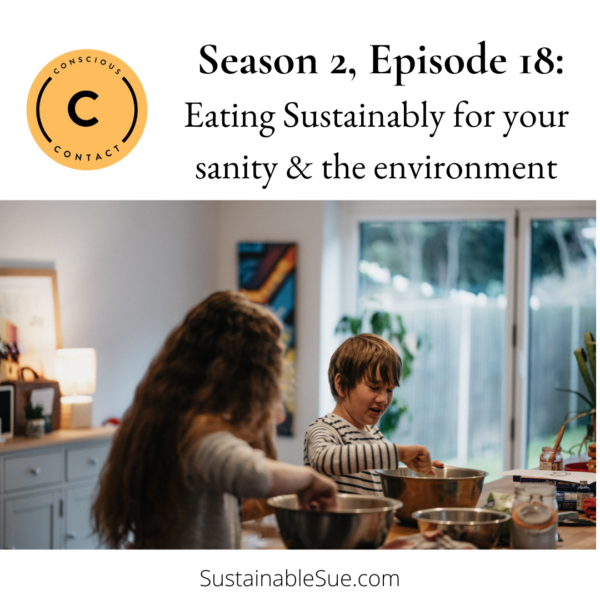On the surface eating sustainably could be viewed as for the environment only, but what about your personal environment – your health, home and happiness?
On the podcast we talked about eating sustainably in a traditional sense – supporting local agencies and those with humane practices. I encourage you to listen to that episode here. I have had additional thoughts since we recorded about what sustainable eating means for each dimension of Sustainable Productivity (SusPro). That is what I want to explore more with you today.
Health and Fitness: Nutrition
Nutrition is a component of the Health and Fitness SusPro dimension. The quality of nutrition has a direct impact on your health. It is probably the most intuitive connection to eating sustainably.
Maybe you choose to eat meat – or not. Maybe you are gluten intolerant – or not. Regardless of what healthy eating means to you, the common theme is to make changes that are sustainable. As you make small adjustments to your nutrition, ask yourself the SusPro questions:
1. Am I getting the outcome I want?
2. Can I continue to do this lifelong if I want to?
If you eliminate a food group because you are trying to be healthy, but don’t have enough energy to be physically active are you really getting the outcome you want?
If you restrict calories thinking it is healthy, but you are hungry and irritated all the time is this something you can continue to do lifelong?
Eating sustainably is as much about habits as the food itself.
Mental Well-being: Relationships
Relationships are a component of the Mental Well-being SusPro dimension. Since food tends to be a natural gathering point, eating sustainably can have a direct impact here. What if you incorporate the idea of eating sustainably into your relationships?
Case Study 1. Eating sustainably means making adjustments for the season of life you are in. Maybe fall means an especially busy couple months for your family. In order to eat healthy in a way that sustains your sanity, this fall means brown bags in the van or picnics at the ball field with your people. Instead of eating in shifts around games and practices, what if you gathered for 15 minutes in a park in between everyone’s destination to eat a cooler dinner. Young kids especially might be delighted by an al fresco dinner party.
Case study 2. It is not too early to think about eating sustainably over the holidays. My husband’s family has a few football coaches in it. In order to give them (and their families) some breathing room these holidays, we are moving our gathering to January or February. What is important is gathering in a low stress time to eat together. One of the things I cherish most about these folks is that they are flexible and know what is important to them. I know so many families who implode if Christmas is not celebrated on December 25. Not my in laws. Sustainable relationships are gathering at a time when we can be focused on each other, not on the clock and having to rush off to the next thing.
Case study 3. What if eating sustainably encompassed experiences with those you are in relationship with? My teenage niece had a slumber part this summer where they made pasta from scratch for their dinner. The idea of pulling these teens away from phones to interact with each other in the kitchen is what eating sustainably means to me. Then bonus when my niece went to visit my dad and she discovered Papa had a Kitchen Aid mixer too! I cried when my sister sent pictures of Sydney cooking for her grandpa. I am sure it is a core memory for him too.

Environmental Surroundings: Physical Clutter
Physical clutter is a component of the Environmental Surroundings SusPro dimension and certainly impacts eating sustainably. Although this has changed over the years, for us it has to do with how we meal plan – we are working on doing a better job at eating what we have. Setting up our physical space to support this is important. Here are a few ways we reduce our physical clutter to support eating sustainably.
1. Clear expired pantry food a couple times each year. I am always stunned to find out spices and hot sauce expire, but they do. Before I met Bixby I thought I was a bad cook. Turns out my spices expired in the 1990s.
2. Pare down appliances. My husband does the cooking and is the gatekeeper to what tools come into his kitchen. He has a rule to not clutter the kitchen with one trick ponies. Garlic press can only press garlic. He has wicked knife skills so it takes less time for him to dice garlic than it does for me to clean the garlic press so out it went.
3. Make things easier to find. We moved seldom used tools to a separate space. There is no need to move the cake decorating tools out of the way every time we need the pasta pot or immersion blender. The once or twice a year we need to decorate a cake, we can pull that box down from the higher shelf.
Sustainable You Questions
1. Can you identify what eating sustainably means to you today, in this season of life?
2. How can you get more of that or reduce the barrier to getting more?
If you like what you read, you might like what you hear. Subscribe to the Conscious Contact podcast on iTunes, Spotify, or wherever you find your podcasts.

Leave A Comment